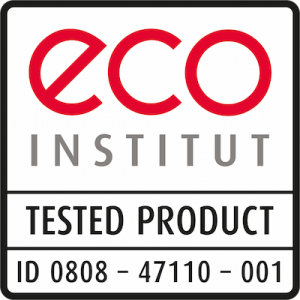When buying latex mattresses, you often find the description “natural latex mattress made of 100 % natural latex” or simply “100 % natural latex”. What is this all about?
The core of natural latex mattresses consists of foamed latex milk. The latex – also called rubber – comes from the milk sap of the rubber tree (Hevea brasiliensis). For natural latex mattresses, the latex is mainly extracted from plantations in Thailand, Malaysia, Indonesia, China and India. The bark of the rubber trees is cut with a knife and the milk sap that flows out is collected via a drainage channel in a container attached to the tree.
From latex milk to mattress core
Latex concentrate is used for the production of mattresses: manufacturers add stabilisers to the latex extracted from the trees to prevent it from clumping together, and then concentrate the mass by centrifuging.

The latex milk is obtained by scratching the bark.
There are two processes for the further processing of the latex concentrate into mattress foam: the Dunlop process and the Talalay process. In both, a so-called vulcanisation takes place – a process in which the liquid latex milk is processed into a foam with permanent elasticity. In the process, isoprene units, which chemically make up the naturally occurring main component of latex, cross-link with sulphur and zinc oxide with the addition of small amounts of auxiliary agents (including dispersants and antioxidants). Most of the excess auxiliaries are washed out after vulcanisation.
“100% natural latex” thus only refers to the fact that the latex used consists entirely of natural latex (latex mattresses can also be made from synthetic, petroleum-based latex, so-called styrene-butadiene rubber, or from mixtures of synthetic and natural latex). That does not mean though that the mattress core exclusively contains this one material – the natural latex: An – albeit very small – proportion is accounted for by the auxiliary materials used in production.
eco-INSTITUT-Label criteria for mattress foams made from natural latex and latexed fibres
In addition to complete mattresses sold directly to consumers, for trade between manufacturing companies, preliminary products such as mattress foams (foam cores without textile covers) can also be tested and certified according to the eco-INSTITUT-Label criteria. The eco-INSTITUT label criteria for mattress foams only apply to natural latex and latexed fibres (e.g. coconut fibres) that are produced with 100 % natural latex without the use of synthetic latex. This means that only mattress foams are certified that consist mostly of renewable raw materials.
 In contrast, the eco-INSTITUT-Label criteria for complete mattresses (including textile covers) also allow synthetic materials. Mattresses made of natural latex, mixtures of natural and synthetic latex as well as mattresses with PUR
foam cores can be certified if they – including the textile covers – comply with the strict requirement values. Vanessa Laumann, head of the certification body at eco-INSTITUT: “With the eco-INSTITUT-Label, we usually only certify products that are sold directly to consumers. Mattress foams are an exception. Here, however, we limit ourselves to the – from our point of view – ecologically advantageous materials natural latex or latexed fibres with a high proportion of renewable raw materials.”
In contrast, the eco-INSTITUT-Label criteria for complete mattresses (including textile covers) also allow synthetic materials. Mattresses made of natural latex, mixtures of natural and synthetic latex as well as mattresses with PUR
foam cores can be certified if they – including the textile covers – comply with the strict requirement values. Vanessa Laumann, head of the certification body at eco-INSTITUT: “With the eco-INSTITUT-Label, we usually only certify products that are sold directly to consumers. Mattress foams are an exception. Here, however, we limit ourselves to the – from our point of view – ecologically advantageous materials natural latex or latexed fibres with a high proportion of renewable raw materials.”
Before a mattress foam can be awarded the eco-INSTITUT-Label, the product must pass extensive laboratory tests. The foams are tested for emissions (including volatile organic compounds, carbon disulphide, nitrosamines and ammonia) and an odour test is carried out. To determine the quality, the amount of fillers is determined – too high a proportion can have a quality-reducing effect. The natural latex content is checked spectroscopically. In the case of latexed fibres, additional analyses are carried out for critical ingredients such as pyrethroids and certain phenols.

Part of a latex core in the test chamber
Another special feature: For mattress foams that have been awarded the eco-INSTITUT-Label, the term ‘100 % natural latex’ must not appear on the certificate. “Because this can lead to misunderstandings, we have agreed together with our customers on the designation ‘Latex – made from 100 % Natural Latexʻ or ‘Natural Latex – made from 100 % Natural Latexʻ. This is because many manufacturers want to prove with the certification that the foam is only made with natural latex, without the use of synthetic latex,” says Vanessa Laumann.
In order to avoid ambiguities when using the eco-INSTITUT-Label in advertising, the following applies to mattress manufacturers: They may only advertise with the eco-INSTITUT-Label if all components of the mattress pass the tests. Using only the label of an inserted foam core for a complete mattress would be misleading from the customer’s point of view and is therefore inadmissible. More information on the topic of “Advertising correctly with the eco-INSTITUT-Label” can be found in our information sheet.
You can find more information about the eco-INSTITUT-Label on our eco-INSTITUT-Label website here. There you can also view or download the criteria for mattresses and latex tests (and other indoor products).
Text: Karin Roth
Photos: Vanessa Laumann, Arne Herzog
